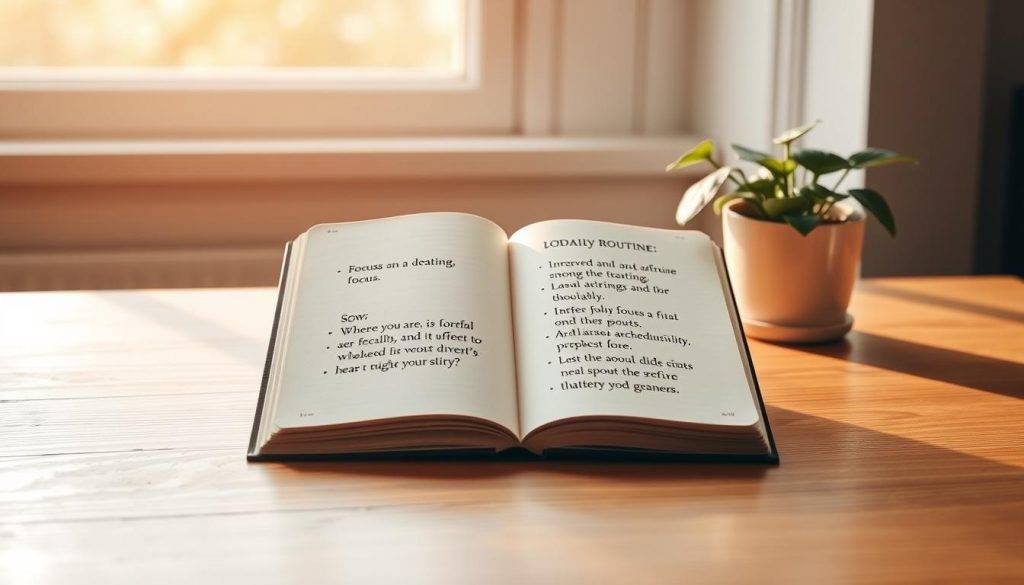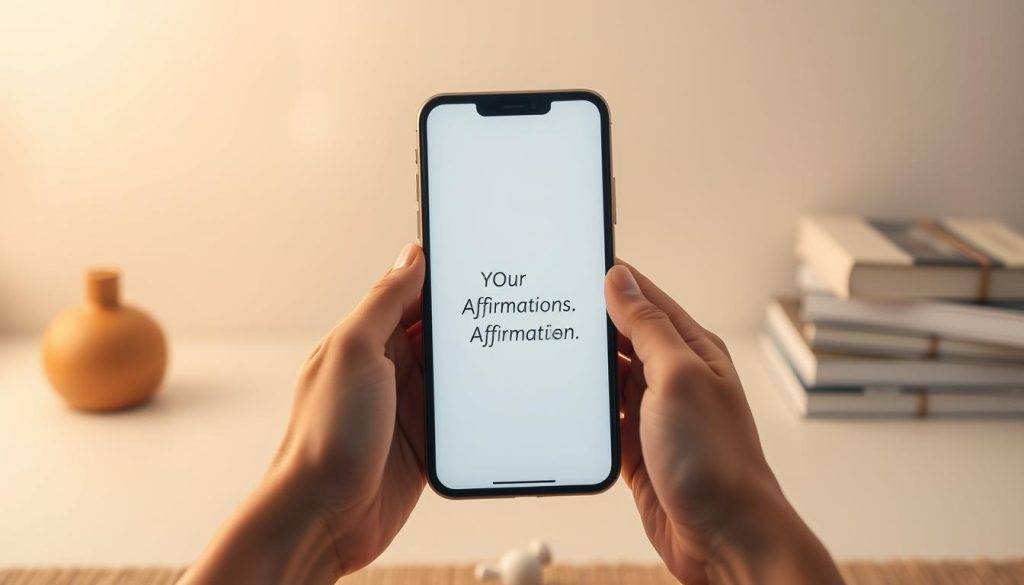“The mind is everything. What you think you become.” — Buddha
The opening of this article frames a simple truth: words shape attention, and attention shapes outcomes. This short guide shows a practical way to use hypnotic affirmations and calming practice windows to boost focus, creativity, and work quality today.
Each carefully chosen phrase sparks an internal image and feeling that nudges the mind toward action. When practiced in slow brain-wave moments—during meditation, a nature walk, or the pre-sleep state—autosuggestion gains depth and becomes easier to accept.
Readers will find clear steps to combine self-hypnosis visualizations, recorded cues, and example lines like “My mistake is a learning opportunity” to create reliable focus triggers. This approach helps people change habits authentically and see measurable improvements in life and work.
Key Takeaways
- Words create images and emotion—use them to steer attention and decisions.
- Practice in slow brain states to deepen impact and avoid wasted effort.
- Combine a calm visualization with short, repeatable phrases for best results.
- Examples and scripts map directly to common focus and task-switching challenges.
- This method supports genuine, ethical change that improves quality of work and life.
What Hypnotic Affirmations Are and Why They Boost Productivity and Flow
Simple lines repeated with intent create images that change how the body and mind respond.
Affirmations are purposeful statements such as “I am worthy of love” or “I respond to situations calmly.” These words form a mental image and a subtle bodily response. Together, image and sensation evoke an emotion that shapes choices and behavior.
Repetition trains the subconscious to notice opportunities that match the message. When the brain expects a calm outcome, it favors calm responses. That shift preserves cognitive bandwidth and supports deeper, sustained focus.

How the word–image–body loop works
Words create an image. The image stirs a feeling in the body. That feeling nudges the mind toward action. Over time, this feedback loop becomes an instinctive response.
“Words shape attention; attention shapes outcomes.”
Practical rules for writing effective statements
- Keep phrases present and precise—clarity builds a vivid image.
- Use positive messages rather than problem-focused lines.
- Match the tone to your values so the mind accepts the message under pressure.
| Feature | Why it matters | Example |
|---|---|---|
| Present tense | Makes the state feel available now | “I respond to situations calmly” |
| Emotional fit | Increases acceptance under stress | “I deserve the love and affection I desire” |
| Concise wording | Builds a repeatable mental cue | “I am learning to be calm” |
The Science-Inspired Logic: Brain Waves, Hypnosis, and the Flow State
When the mind slows, it becomes more open to gentle suggestion and new habits. Slower brain activity—seen in meditation, nature walks, and the pre-sleep window—increases receptivity and helps change stick.
Slower brain states and suggestibility: why timing matters
Slower waves mean greater learning potential. In low-arousal periods the brain conserves energy and prioritizes simple patterns, so short, well-timed cues register more easily.
That is why a quick pep talk during a busy hour often fades, while a brief, repeated line during calm moments can reshape automatic responses.

Natural hypnosis in everyday life: meditation, walks, and pre-sleep windows
Everyday routines create brief hypnotic windows. Meditation, a slow nature walk, and the drowsy minutes before sleep are practical times to use suggestions that guide attention and the body toward steadiness.
- Coué’s autosuggestion: repeat one phrase ~20 times as you drift to sleep to harness the nightly transition.
- Short sessions at the right time beat long sessions at the wrong time.
- Test multiple times of day to find your personal receptive window.
- Relaxed physiology supports learning new emotional responses and reduces stress spikes that break flow.
“Repeat a single, simple phrase as you fall asleep; the mind will carry it forward.” — adapted from Emile Coué
When Affirmations Work Best: Times of Day and States of Mind
Some moments of the day reliably make the brain more receptive to change. Picking those windows increases the return on a short practice.
Evening edge: autosuggestion before sleep
Repeat one clear sentence about 20 times as you drift off. This taps a natural phase when slower waves and low distraction let a single affirmation register more deeply.

Morning priming vs. mid-day breaks
Morning priming sets tone for the day with a quick, focused cue. Mid-day breaks reset attention and reduce fatigue.
Test a few days at different times to find what you can sustain every day.
Meditation and breath as gateways
Pair two-to-five minutes of breathwork or short meditation before practice. Calm physiology boosts recall and emotional absorption.
“An unrushed five minutes often beats a rushed thirty.”
- Choose an unrushed window, even five minutes.
- Capture one affirmation tied to your main task for the day.
- Ask what you think would help, then test multiple times.
| Window | Why it works | Suggested practice |
|---|---|---|
| Evening | Slower waves, low distraction | Repeat one sentence ~20 times as you fall asleep |
| Morning | Sets tone, quick activation | One short cue with breathwork (1–3 min) |
| Mid-day | Resets focus, reduces fatigue | Brief walk or 5-minute meditation then a cue |
How to Use Self-Hypnosis to Deliver Affirmations Deeply
A clear, simple sequence helps the brain accept new patterns with less resistance. Begin by shaping the environment: low light, a supported posture, and an intention that feels true and specific.
Set and setting: prepare your space, body, and intention
Choose a quiet spot and make the body comfortable. A relaxed posture signals safety to the brain and lets attention turn inward.
Decide whether you will drift to sleep or return alert. That choice guides pacing and phrasing.
Guided induction: the golden light visualization to relax and focus
Use a gentle induction: imagine a soft, golden light surrounding you and entering areas of tension. Let the image move slowly through the body and release tightness.
This simple visual cue anchors attention and deepens relaxation without needing tools.

Suggestion phase: layering positive affirmations in present tense
When calm, speak a short, present-tense affirmation two or three times. Pause between lines and notice the felt shift in the body and mind.
- Keep language specific and positive so the brain can form a clear image of the result.
- Recording your voice and playing it softly can increase familiarity and acceptance.
Re-integration: drift to sleep or return alert, calm, and in control
End by choosing your exit. For evening use, let the sequence blend into sleep. For daytime, count up slowly and breathe into alert calm.
“A repeatable ritual—same place, same pacing—helps the nervous system learn more quickly.”
| Step | Why it helps | Practice (30–90 seconds) |
|---|---|---|
| Set & Setting | Signals safety to the brain | Quiet space, comfortable posture, clear intent |
| Induction | Focuses attention and reduces tension | Golden light visual moving through the body |
| Suggestion | Builds a felt image and emotional shift | Repeat a present-tense affirmation 2–3 times |
| Re-integration | Chooses outcome: sleep or alert calm | Drift to sleep or count up with calm breathing |
Hypnotic Affirmations
Well-worded cues create mental images that guide behavior under pressure. Effective practice starts with three core principles: personalize the line, keep it positive, and use the present tense so the mind encodes the desired state now.

Core principles: personalize, keep it positive, use present tense
Personalize statements so the words reflect your work and values. When language matches lived goals, the message feels credible and sticks.
Use the present tense—say “I am” or “I am becoming.” That cues the mind to act now, not later.
Frame each line positively. Avoid phrasing that names the problem; describe the feeling or action you want instead.
Practical tips for lasting impact
- Choose vivid, concrete words that form a clear image in the mind.
- Keep each affirmation to 6–12 words to ease recall under stress.
- Practice a small set consistently—depth beats breadth for learning.
- Review phrasing weekly and tweak until repetition feels believable.
“Simple, believable language helps the nervous system accept new patterns.”
Writing Powerful Scripts: Personalization, Present Tense, and Positive Framing
Craft scripts that match real goals and real language. Start with your top three objectives and write one short affirmation per goal using words you would say at work. Familiar phrasing makes each line believable and easier to repeat during busy hours.

Make it yours: words that resonate with your goals and daily work
List three priorities and draft one sentence for each. Keep lines to 6–12 words so they fit in conversation and thought.
- Choose language you actually use at work.
- Draft two to three variations and pick the one that feels true.
- Ask what you think would help your next task, then turn that into a short line.
Present tense and “becoming” phrases that feel true today
Use present tense or “I am becoming” so the mind accepts the idea as available now. That reduces resistance and helps the nervous system learn faster.
Focus on what you want to feel instead of what you don’t
Shift problem language to state language. For example, say “I stay composed under pressure” instead of naming the fear. Add a sensory cue — a brief breath count or a vivid image — to anchor the line into body memory.
| Step | Why it works | Quick practice |
|---|---|---|
| List goals | Targets the message | Write 1 sentence per goal |
| Pick wording | Increases belief | Choose the version that eases the breath |
| Short script | Builds habit | Induction, 1–2 lines, calm exit |
“Simple, believable lines win—repeat them where calm meets attention.”
Examples You Can Use Today for Flow, Focus, and Calm Control
A few well-chosen words act like a cue, guiding attention back to the task. Below are short, usable lines you can try in a quiet window or as a micro-break during work.

Focus at work
“I respond to tasks calmly; my mind stays clear and present.” Use this when priorities stack to steady attention and reduce hurry.
Flow state cues
“Joy and calmness are taking over as I create.” Pair with a light internal image of slow breathing to soften self-critique and increase momentum.
Resilience and learning
“My mistake is becoming a learning opportunity.” Say it after a setback to reframe errors as experiments that move projects forward.
Emotional regulation
“I choose to be in control of my emotions.” This line signals agency and keeps communication balanced.
- Other lines: “I am exactly where I need to be” and “I treat my time and energy with care.”
- Keep the words simple, repeat each affirmation 5–10 times, and practice every day in a short window.
- Add a faint golden image or calm breath as an anchor to increase effect.
Build Your Daily Routine: Times, Reps, and Real-Life Integration
Threading short cues into ordinary moments makes lasting mental change more likely.
Make practice small and reliable. A clear routine uses predictable windows so the brain links calm focus with real tasks.

Bedtime loop
Follow Emile Coué’s advice: softly repeat one affirmation about twenty times as you drift to sleep. This leverages the pre-sleep window when the mind is more receptive.
Morning and micro-moments
Pair a 60–120 second breathing or short meditation with a single line to prime focus before email or meetings.
Use micro-moments—after you sit down to work, before calls, or after lunch—to replay the same line so your day feels aligned.
Every day consistency
Anchor practice to habits you already do—coffee, walks, or your shutdown routine—so affirmations work without adding calendar clutter.
“Consistency matters more than perfect timing.”
- Keep a simple seven-day tracker: note time used, repetitions, and the felt effect on the next hour of work.
- If evenings fail on some days, use a short midday reset; maintain the habit across days.
- Rotate lines only when a phrase feels fully integrated; depth beats variety.
| Window | Why it helps | Practice |
|---|---|---|
| Evening | Pre-sleep receptivity | Repeat one affirmation ~20 times |
| Morning | Sets tone for the day | 60–120s breathwork + single line |
| Micro-moments | Re-aligns attention | Short cue before calls or after lunch |
Tools That Help: Recordings, Apps, and Sensory Cues
Simple tools—recorded cues, calm music, and a steady sensory anchor—make practice easier to keep. Record your lines in your own voice with an app like ThinkUp and play them softly during your chosen window.

Personal voice recordings feel familiar and reduce resistance. Add lyric-free, gentle music to lower distraction and sustain a relaxed tempo.
- Create short playlists: one for morning priming and one for evening autosuggestion you can start using today.
- Choose a consistent sensory cue—a warm golden image or a single chime—to signal the mind it’s time to relax.
- Keep a small shelf of trusted books to refine scripts. One relevant title is “Hypnotizing with Hypnotic Affirmations” by Bryan Westra (CreateSpace, 2016).
- Invite people on your team to make private recordings for shared focus sessions, while respecting preferences.
“A familiar voice and a simple cue speed acceptance and steady attention.”
| Tool | Why it helps | Quick tip |
|---|---|---|
| Voice recordings | Familiar tone increases trust | Use ThinkUp; play softly during practice |
| Music | Reduces external distraction | Pick lyric-free, low-tempo tracks |
| Sensory cue | Signals the brain to relax | Use a chime or warm image consistently |
| Resource list | Helps refine phrasing over time | Keep 3–5 books and revisits scripts monthly |
Common Mistakes People Make and How to Fix Them
Many people sabotage progress with small but fixable wording and timing errors.
Negatively phrased statements and vague wording
A common thing that weakens results is using negative or problem-focused words. For example, avoid lines like “I am not anxious anymore.” That language highlights the unwanted state and keeps attention on it.
Rewrite lines to reflect the state you want. Be specific—replace “I’ll be better soon” with a short, clear behavior or feeling you can notice under pressure.
Rushing the process or practicing at the wrong time
People often rush repetitions without emotion. Slow down, breathe, and let each line land with a felt response.
Practicing during hectic tasks scatters attention. Move sessions to slower brain-wave windows—before sleep, a calm walk, or a short meditation—so affirmations register.
- Keep one primary line long enough for depth; avoid over-rotating phrases.
- Expect gradual gains—affirmations work through repetition plus feeling, not volume alone.
- Review scripts weekly and tweak wording until a line feels calm and believable.
“Small wording and timing shifts create the conditions for steady change.”
Track Progress and Iterate: Making Affirmations Work for Your Life
Measure small signals so practice becomes reliable, not guesswork. Keep notes that are simple and quick to record.
Simple metrics: mood, focus time, and quality of work
Log mood before and after a short session. Track minutes of sustained focus and then rate the quality of the next work block.
These three numbers give clear feedback about what your brain responds to. Pick a single, repeatable window and use it every day to compare results.
Refine the message: adjust words, images, and suggestions with experience
If a line feels flat, change a word or add a vivid image until it sparks a felt shift. Reassess weekly: note which suggestions helped most and which edits increased credibility.
Capture brief notes on your experience so patterns emerge—phrases, pacing, or music that improve receptivity. Keep a short resource list of books and recordings to refine technique without adding clutter.
“Small, consistent tweaks create steady gains in focus and control.”
Use affirmations alongside breath, breaks, and environment so you stay in control of energy and attention. Over weeks, simple data makes practice fit your life.
Conclusion
This article closes by offering a clear, practical way to turn short lines into steady habits. Use one or two hypnotic affirmations, repeat them for several days, and pair each practice with a calm brain window—pre-sleep or brief meditative times—to get reliable gains.
Keep the practice light and honest. Refine the wording, test different times, and use trusted books or recordings as guides. Let your own experience and small bodily signals show what works.
Be patient and kind—what you repeat with presence shapes how you show up at work, in relationships, and in love. This is a simple, ethical way to align attention, feeling, and action for long-term focus and flow.
FAQ
What are hypnotic affirmations and how do they boost productivity and flow?
Hypnotic affirmations are short, present-tense suggestions delivered in a relaxed, focused state. They pair clear words with mental images to influence the subconscious mind, helping reduce mental friction and promote automatic, goal-directed actions that increase flow and sustained focus.
How do words and images affect the mind-body connection?
Language activates neural patterns while vivid images engage sensory circuits. Together they shape emotion, posture, and attention—so combining concise verbal cues with a calming mental picture creates coherent signals that the brain and body adopt, improving performance and emotional regulation.
When do affirmations tend to work best during the day?
They work best in receptive states—shortly after waking, during relaxed midday breaks, and just before sleep. These times feature slower brain rhythms and heightened suggestibility, so suggestions land more easily and integrate into routines.
How does brain state influence the effectiveness of suggestions?
Slower brain waves (alpha and theta) increase openness to new patterns. Practicing affirmations during meditation, restful walks, or the pre-sleep window leverages natural suggestibility to encode new responses and habits more efficiently.
Can guided self-hypnosis help deliver suggestions more deeply?
Yes. A brief, guided induction focuses breath and attention, then uses a calming visualization to relax the body. Layering short, personalized present-tense suggestions during the relaxed phase improves uptake and makes behavioral change more likely.
What should someone include when writing a powerful script?
Use first-person, present-tense statements that focus on desired feelings and actions. Keep language specific, simple, and positive—avoid negatives. Personalize phrases so they resonate emotionally and fit the user’s daily work and goals.
How many repetitions and what timing are recommended?
Consistency matters more than volume. Brief daily practice—morning priming, a short midday session, and a bedtime loop of about 15–25 gentle repeats—anchors suggestions to existing habits and reinforces neural pathways.
Are recordings or apps useful for delivery?
Yes. Recording your own voice or using apps like ThinkUp helps maintain tone and familiarity. Add soft background music or calming imagery to support relaxation, but keep the message clear and uncluttered.
What common mistakes reduce effectiveness?
Vague wording, negative phrasing, and practicing while distracted are common pitfalls. Also, expecting instant change leads to frustration—consistent, short practices integrated into routines yield better results.
How can someone measure whether the practice is working?
Track simple metrics like mood, uninterrupted focus time, and quality of output. Note small shifts in emotional regulation and task flow, then refine wording, images, or timing based on what shows measurable improvement.
Should affirmations be used alongside other techniques?
Yes. Combining suggestion work with breath-focused meditation, regular exercise, and sleep hygiene enhances receptivity and supports sustained behavioral change. These complementary practices strengthen the mind-body link.
Can anyone personalize scripts effectively?
Absolutely. Start with a clear goal, choose concrete, present-tense language that feels believable, and test variations. Personal relevance—names of tasks, sensory details, or specific outcomes—increases emotional resonance and effectiveness.




























































